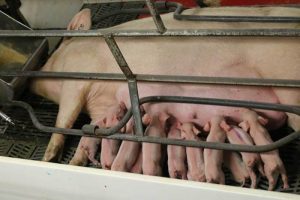
Step right up as we explore the fascinating world of livestock farming in the US! From its historical roots to its economic impact, get ready for an insightful journey filled with interesting facts and figures.
Discover the different types of livestock raised, the latest technology in animal husbandry, and the crucial aspects of health and welfare in this engaging discussion.
Livestock Farming in the US
Livestock farming in the US refers to the practice of raising animals for food, fiber, and other products. It plays a significant role in the agricultural sector and economy of the country.
History of Livestock Farming in the US
Livestock farming has been a part of American agriculture since the early colonial days. European settlers brought livestock such as cattle, pigs, and sheep to the New World, which eventually led to the development of large-scale commercial farming operations.
Types of Livestock in the US
The most commonly raised livestock in the US include cattle, pigs, poultry, and sheep. Cattle farming is particularly prominent, with both beef and dairy cattle being raised for meat and milk production.
Economic Impact of Livestock Farming in the US
Livestock farming contributes significantly to the US economy, generating billions of dollars in revenue each year. According to the USDA, the livestock sector accounted for over half of the total cash receipts from agricultural commodities in recent years, highlighting its importance in the agricultural industry.
Animal Husbandry Practices
Animal husbandry practices in the US livestock farming industry play a crucial role in ensuring the health and well-being of animals, as well as the efficiency and sustainability of operations. From traditional methods to modern technologies, a variety of practices are employed to manage and care for livestock.
Common Animal Husbandry Practices in the US
- Regular health check-ups and vaccinations to prevent diseases.
- Proper nutrition through balanced diets and access to clean water.
- Comfortable and clean living conditions to promote animal welfare.
- Breeding programs to improve genetic traits and overall productivity.
Use of Technology in Modern Animal Husbandry
- Monitoring systems to track animal health, behavior, and productivity.
- Automated feeding systems for precise nutrition management.
- Genetic technologies for selective breeding and disease resistance.
- Environmental control systems for regulating temperature and ventilation in barns.
Sustainable Practices in Livestock Farming
- Implementing rotational grazing to preserve pasture health and reduce erosion.
- Utilizing manure as fertilizer for crops to minimize waste and improve soil quality.
- Investing in renewable energy sources to reduce carbon footprint.
- Adopting integrated pest management strategies to minimize chemical usage.
Comparison of Traditional vs. Modern Animal Husbandry Methods
- Traditional methods often rely on manual labor and experience, while modern methods incorporate technology for efficiency.
- Modern animal husbandry emphasizes data-driven decision-making and precision management.
- Traditional practices may have a stronger focus on animal husbandry skills passed down through generations.
- Modern methods prioritize sustainability, animal welfare, and overall farm profitability.
Livestock Health and Welfare
Livestock health and welfare are crucial aspects of livestock farming in the US. Ensuring the well-being of animals not only promotes ethical practices but also contributes to the overall quality and productivity of the livestock.
Common Health Issues Faced by Livestock in the US
- Pneumonia: Common in cattle, especially calves, due to stress, poor ventilation, and overcrowding.
- Foot Rot: A bacterial infection affecting the hooves of cattle, leading to lameness and decreased mobility.
- Mastitis: Inflammation of the udder in dairy cows, often caused by bacterial infections.
- Parasitic Infections: Worms and external parasites can cause significant health issues in livestock.
Regulations and Standards for Livestock Welfare
- The Animal Welfare Act: Federal law setting standards for the treatment of animals in research, exhibition, transport, and by dealers.
- The Humane Methods of Livestock Slaughter Act: Regulates the treatment of animals during slaughter to minimize stress and pain.
- State Regulations: Each state may have additional regulations and standards for livestock welfare that farmers must adhere to.
Advancements in Veterinary Care for Livestock
- Genetic Testing: Allows for the identification of genetic conditions and the selection of healthier breeding stock.
- Telemedicine: Enables remote consultations with veterinarians, improving access to healthcare for livestock in rural areas.
- Probiotics and Nutraceuticals: Supplements that promote gut health and overall well-being in livestock.
Environmental Impact

Livestock farming in the US has a significant environmental impact, contributing to issues such as deforestation, water pollution, and greenhouse gas emissions. The large-scale production of livestock requires vast amounts of land for grazing and feed production, leading to deforestation and habitat destruction. Additionally, the waste produced by livestock can contaminate water sources, affecting both aquatic ecosystems and human populations.
Livestock also release methane, a potent greenhouse gas, into the atmosphere, contributing to climate change.
Sustainable Practices
Implementing sustainable practices in livestock farming can help reduce the environmental footprint of the industry. This includes practices such as rotational grazing, which helps maintain soil health and reduce erosion, as well as utilizing manure as fertilizer to minimize waste. Sustainable feed sourcing, water conservation, and energy-efficient facilities are also important factors in promoting environmentally friendly livestock farming.
Relationship with Climate Change
The relationship between livestock farming and climate change is complex. While livestock contribute to greenhouse gas emissions, sustainable practices can help mitigate these effects. For example, planting trees on grazing land can sequester carbon dioxide, offsetting the methane emissions from livestock. Additionally, improving feed efficiency and reducing food waste can help reduce the overall carbon footprint of livestock production.
Initiatives for Environmentally Friendly Farming
Several initiatives in the US promote environmentally friendly livestock farming practices. Programs such as the Environmental Quality Incentives Program (EQIP) offer financial assistance to farmers implementing conservation practices. The USDA’s Natural Resources Conservation Service provides technical support and resources to help farmers improve soil health and water quality. These initiatives aim to support farmers in adopting sustainable practices that benefit both the environment and their businesses.
Wild Animals

Wild animals play a crucial role in the US ecosystem, contributing to biodiversity and maintaining ecological balance. They are essential for seed dispersal, pollination, and controlling pest populations.
Conservation Efforts
Conservation efforts in the US aim to protect and preserve wild animal populations through measures such as habitat restoration, wildlife corridors, and protected areas like national parks and wildlife reserves. Organizations work to raise awareness, conduct research, and implement conservation strategies to safeguard endangered species.
Impact of Livestock Farming
Livestock farming can have a significant impact on wild animal habitats, leading to habitat destruction, pollution of water sources, and competition for resources. Encroachment of livestock into natural habitats can disrupt ecosystems and threaten the survival of native species.
Coexistence Examples
Efforts have been made to promote coexistence between livestock farming and wild animals. Practices such as rotational grazing, fencing, and predator-friendly management techniques help reduce conflicts between livestock and wildlife. Some ranchers work collaboratively with conservationists to implement conservation easements and habitat restoration projects on their lands.
Conclusion
As we wrap up our exploration of livestock farming in the US, remember the intricate balance between agriculture and animal welfare. With sustainable practices and advancements in veterinary care, the future looks promising for both farmers and livestock alike.
FAQ Explained
What are some common animal husbandry practices in US livestock farming?
Common practices include vaccination schedules, proper nutrition plans, and regular health check-ups to ensure the well-being of the livestock.
How does livestock farming impact the environment?
Livestock farming can contribute to greenhouse gas emissions and land degradation, but sustainable practices like rotational grazing can help mitigate these effects.
What are some advancements in veterinary care for livestock?
Technological innovations such as telemedicine and precision farming have revolutionized veterinary care, allowing for early disease detection and personalized treatment plans.





